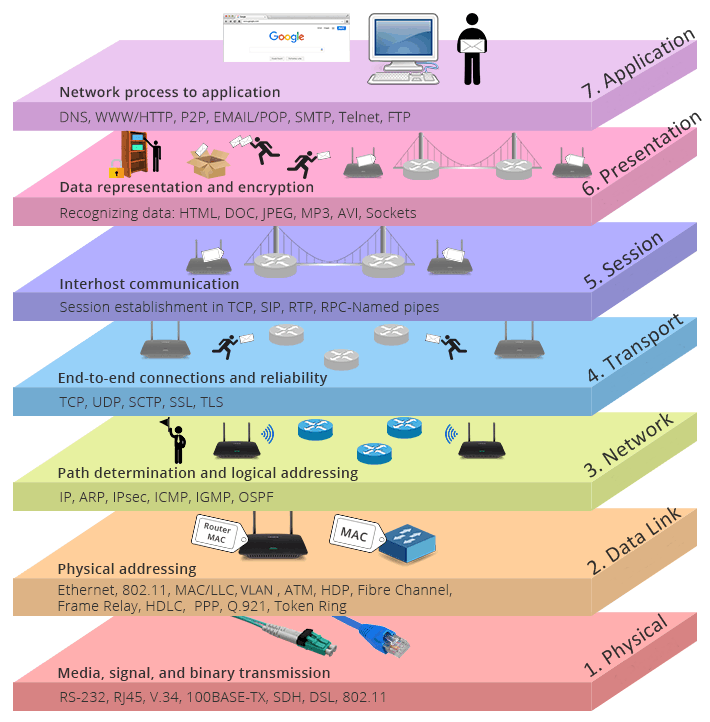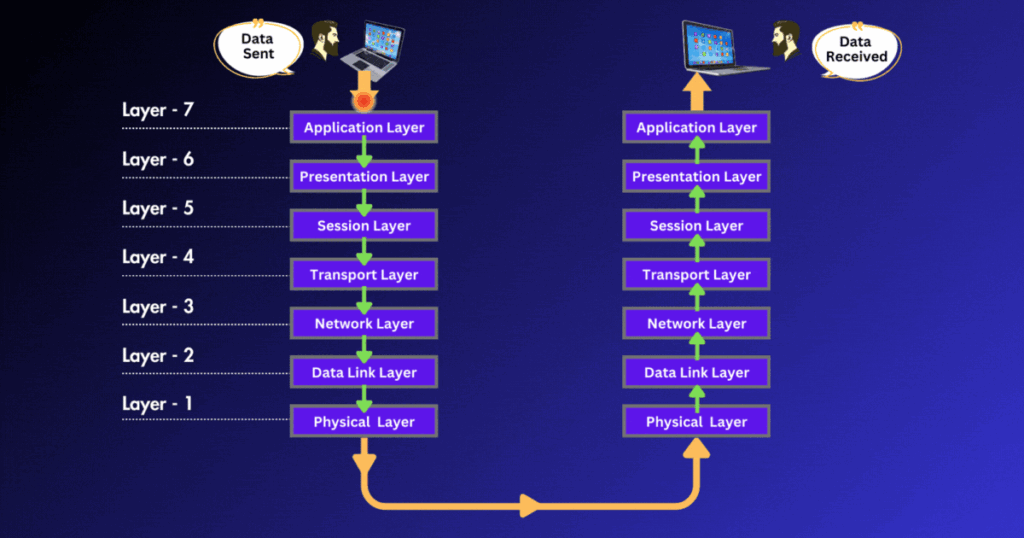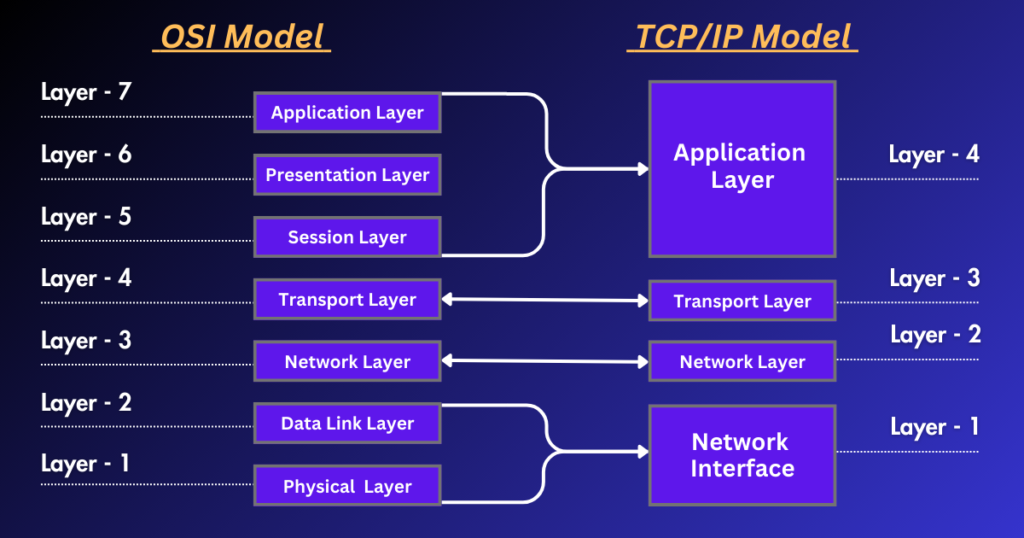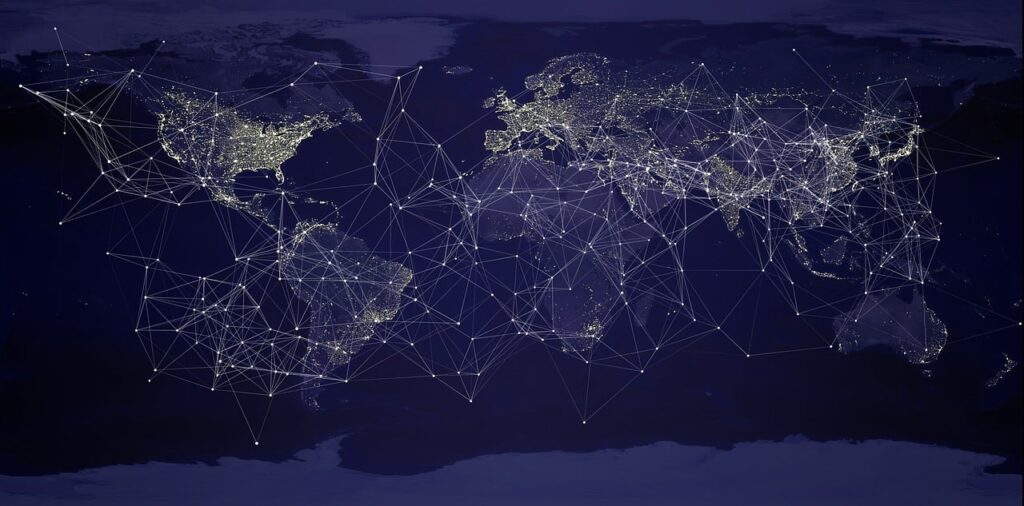Introduction
Welcome back to our “Networking for Hackers” series! Today, we’re jumping into Part 4, where we’ll explore the TCP/IP and OSI models. Think of them as the behind-the-scenes guides to how computers talk to each other online. We’ll keep things simple and easy to grasp, whether you’re new to this or just brushing up.
Let’s dive in and uncover the secrets of internet communication!
What Is OSI Model in Computer Networking?
Ever heard of the OSI model? It’s like the superhero blueprint for how our tech gadgets communicate. Picture it as a master plan with seven layers, making sure everything talks to each other in a language they all understand. The brains behind this operation? The International Organization for Standardization (ISO). They wanted to make sure that no matter what tech you’re using, it can play nice with others. So, in a nutshell, the OSI model is like the universal translator for our digital world!
7 Layers Of OSI Model

1. Physical Layer
At the very bottom of the OSI model, you’ll find the Physical Layer. This layer is where things get real—it’s all about sending and receiving raw data, like the actual 1s and 0s, through cables or wireless signals. Think of it as the hardware side of things, setting up how fast data can move and what kind of plugs to use. It’s basically the foundation that makes sure your data can travel from one place to another smoothly.
2. Data Link Layer
Now, moving up a bit in the OSI model, we hit the Data Link Layer. This layer is like the traffic cop for data frames, making sure they get from one stop to another smoothly on the same neighbourhood network. It’s got a handy error-checking tool to fix any hiccups from the Physical Layer and knows how to talk to devices nearby using these things called MAC addresses. You can think of switches as the helpers here, making sure data gets to the right houses by looking at those MAC addresses.
3. Network Layer
Picture it like this: it’s the traffic controller for your data. Its main job? Figuring out the best route for your information to travel from point A to point B, even if it means crossing different networks. It’s all about using logical addresses (you might know them as IP addresses) to map out the smoothest path. And who’s doing all this decision-making? Routers – they’re like the traffic cops, directing your data where it needs to go based on those IP addresses.
4. Transport Layer
Now, let’s talk about the Transport Layer. This layer’s job is to make sure data gets from one end system to another, like from your computer to a server. It breaks down the data into smaller bits, making sure they all get where they need to go without any mistakes. Plus, it keeps an eye on how fast things are moving and fixes any errors that pop up along the way. You might’ve heard of TCP and UDP – those are just a couple of the ways this layer gets the job done.
5. Session Layer
This layer is like the organizer of the party, making sure everyone knows when to start, how to communicate, and when to wrap things up. It’s all about setting up, keeping track of, and closing down these communication sessions between different apps on different devices. So, if you ever wondered how apps on your phone or computer keep their conversations in order, well, this layer’s got it covered.
6. Presentation Layer
This layer takes care of translating, compressing, encrypting, and decrypting data. It handles things like changing data into a format that different apps can understand, kind of like converting between languages. Think of it like a language translator for computers. It also smooths out any wrinkles in how data looks on different gadgets and systems. It’s the tech middleman making sure everyone gets what’s being said.
7. Application Layer
Now, let’s talk about the Application Layer – it’s right at the top of the OSI model. This layer is like the friendly face that directly chats with the applications you use every day. It’s all about giving those apps the services they need. Inside, you’ve got different sets of rules and tools, like HTTP for web surfing, SMTP for emails, and FTP for moving files around. It’s basically the go-to spot for making sure your favourite apps can do their thing smoothly.
Data Transfer In OSI Layers

When you send a message to a friend, it goes through different layers of communication:
- At the Application Layer, your message gets ready to be sent.
- In the Presentation Layer, it might get compressed to save space.
- The Session Layer sets up the connection for sending the message.
- Next, the message gets broken into smaller parts, or packets, at the Transportation Layer for efficient sending.
- Then, at the Network Layer, these packets are given addresses for routing.
- The Data Link Layer puts the packets into frames, like envelopes, for sending.
- Finally, at the Physical Layer, these frames become binary signals for traveling over cables or wireless.
When your friend receives the message, it goes through the layers in reverse:
- At the Physical Layer, the binary signals become frames again.
- The Data Link Layer puts these frames back into packets.
- Next, at the Network Layer, the packets come together again to form the complete message.
- The Transportation Layer puts together the segmented message.
- The Session Layer ends the communication session.
- In the Presentation Layer, any compression is undone.
- Finally, at the Application Layer, the message is in a readable format for your friend.
The OSI model in networking is like a roadmap for making sure all this communication happens smoothly. It helps devices talk to each other the right way.
TCP/IP Model in Computer Networking

Now, let’s talk about the TCP/IP model. It’s another way of looking at how computers communicate, but it keeps things simpler with just four layers. It came about because as the internet grew, people needed a more flexible framework. It was created back in the 1970s by a team of researchers led by Vinton Cerf and Bob Kahn. This model works a lot like the OSI model, but with fewer layers. It’s like a streamlined version, focusing on the essentials.
The 4 Layers of the TCP/IP Model
- Physical Layer, sometimes called the network interface or data link layer. This layer is all about what happens at the connection point between devices on a network. It’s like the bridge that links everything together, making sure data can move smoothly between different devices. The protocols in this layer, like Ethernet for local networks and Address Resolution Protocol, handle the nitty-gritty of how data gets from one place to another.
- Network Layer, sometimes known as the internet layer. This layer’s job is to handle packets and link up different networks so they can pass those packets around, even if they’re from different places. In simple terms, it’s like the middleman making sure data gets where it needs to go. The main players here are IP and the Internet Control Message Protocol (ICMP), which helps out by reporting any errors that crop up along the way.
- Transport Layer is like the conductor of an orchestra, ensuring smooth communication from one end of the network to the other. It’s got a couple of key players: TCP, which takes care of most communications between devices, making sure everything flows smoothly and reliably; and User Datagram Protocol (UDP), which steps in for special cases where TCP isn’t quite the right fit. Together, they keep the conversation going strong across the network.
- Application Layer is all about making sure different applications can share data in a way that everyone understands. You’ve probably heard of some of its protocols, like HTTP, FTP, and email stuff like SMTP and POP3. Basically, at this level, we’re dealing with the actual data that applications send and receive. It’s like the language they use to talk to each other.
Just like the OSI model, it helps make sure that different devices and networks can understand each other, keeping the internet running smoothly.
Conclusion
To sum up, both the TCP/IP model and OSI model in Computer Networking are super helpful in understanding how networks work. While TCP/IP is what you’ll usually see in action, the OSI model gives a broader view of how network communication happens. Knowing these computer networking models inside out gives hackers a leg up in finding and exploiting network weaknesses.
In the next part of our “Networking For Hackers” series, Part 5, we’ll dig into important ports and protocols. We’ll talk about TCP and UDP handshakes and why they’re so crucial in network talk. So, stick around for more cool stuff about hacking and networking!
Subscribe to Our FREE Daily Newsletter For Hacker’s & Tech. Students
New here? Read “Networking For Hacker’s | Part-1” & Follow Us on Instagram, LinkedIn, Facebook



